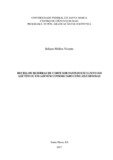| dc.creator | Vicente, Juliano Melleu | |
| dc.date.accessioned | 2017-08-24T12:09:09Z | |
| dc.date.available | 2017-08-24T12:09:09Z | |
| dc.date.issued | 2017-02-23 | |
| dc.identifier.uri | http://repositorio.ufsm.br/handle/1/11566 | |
| dc.description.abstract | The ingestive behavior and the ingestion of forage by beef heifers were evaluated in the vegetative and flowering stages of ryegrass (Lolium multiflorum L.). The treatments were: grazing exclusively on ryegrass, ryegrass intercropping with vetch (Vicia sativa L.) or red clover (Trifolium pratense L.). The grazing method was continuous with variable stocking. The experimental design was the completely randomized with repeated measures arrangement, three forage systems and three repetitions of area. For evaluations of forage intake, chromic oxide was used as an indicator of fecal production and heifers were considered as experimental units. The forage mass, allowance of forage and allowance of leaf blades were, 1596.2 kg / ha DM, 12 kg DM / 100 kg BW and 4.5 kg DM / 100 kg BW respectively. The participation of vetch and red clover in the forage mass corresponded to 13.2% and 4.5% respectively in the vegetative stage. In the flowering stage, the participation of legumes corresponded to 0.6%. In forage as grazed, crude protein (17.8%), neutral detergent fiber (55.8%) and in situ dry matter digestibility (76.7%) were similar among forage systems. These variables differed between phenological stages of ryegrass. The grazing time differed between the systems being superior in the system with vetch. The forage intake rate in the clover system was higher than the other systems. The dry matter intake was similar among forage systems and was higher in the vegetative stage compared to the flowering stage. The average daily gain was similar among forage systems and phenological stages. With little participation of red clover or vetch in the herbage mass intercropped with ryegrass, it does not modify the intake of dry matter, crude protein and neutral detergent fiber, resulting in the same performance of beef heifers. | eng |
| dc.description.sponsorship | Coordenação de Aperfeiçoamento de Pessoal de Nível Superior - CAPES | por |
| dc.language | por | por |
| dc.publisher | Universidade Federal de Santa Maria | por |
| dc.rights | Attribution-NonCommercial-NoDerivatives 4.0 International | * |
| dc.rights.uri | http://creativecommons.org/licenses/by-nc-nd/4.0/ | * |
| dc.subject | Lolium multiflorum Lam. | por |
| dc.subject | Trifolium pratens L. | por |
| dc.subject | Vícia sativa L. | por |
| dc.subject | Óxido de cromo | por |
| dc.subject | Tempo de pastejo | por |
| dc.subject | Lolium multiflorum Lam. | eng |
| dc.subject | Trifolium pratense L. | eng |
| dc.subject | Vícia sativa L. | eng |
| dc.subject | Chromic oxide | eng |
| dc.subject | Grazing time | eng |
| dc.title | Recria de bezerras de corte sob pastejo exclusivo em azevém ou em azevém consorciado com leguminosas | por |
| dc.title.alternative | Rearing of beef heifers under exclusive pasture in italian ryegrass or italian ryegrass consorced with legumes | eng |
| dc.type | Dissertação | por |
| dc.description.resumo | Foram avaliados o comportamento ingestivo e a ingestão de forragem por bezerras de corte, nos estádios vegetativo e de florescimento do azevém (Lolium multiflorum L.). Os tratamentos foram: pastagem exclusiva de azevém, azevém consorciado com ervilhaca (Vícia sativa L.) ou com trevo vermelho (Trifolium pratense L.). O método de pastejo foi o contínuo com lotação variável. O delineamento experimental foi o inteiramente casualizado com medidas repetidas no tempo, três sistemas forrageiros e três repetições de área. Para as avaliações da estimativa de ingestão de forragem, foi utilizado o óxido de cromo como indicador da produção fecal e as bezerras foram consideradas as unidades experimentais. A massa de forragem, oferta de forragem e oferta de lâminas foliares foram: 1596,2 kg/ha de MS, 12 kg de MS/100 kg PC e 4,5 kg de MS/ 100 kg PC, respectivamente. A participação de “ervilhaca” e “trevo vermelho” na massa de forragem correspondeu a 13,2% e 4,5% respectivamente no estádio vegetativo. No estádio de florescimento o percentual das leguminosas correspondeu a 0,6%. Na forragem da simulação do pastejo, a proteína bruta (17,8%), fibra em detergente neutro (55,8%) e digestibilidade in situ da matéria seca (76,7%), foram similares entre os sistemas forrageiros. Essas variáveis diferiram entre estádios fenológicos do azevém. O tempo de pastejo diferiu entre os sistemas sendo superior no sistema com ervilhaca. A taxa de ingestão de forragem no sistema com trevo foi superior aos demais sistemas. A ingestão de matéria seca foi similar entre os sistemas forrageiros e foi maior no estádio vegetativo em relação ao estádio de florescimento. O ganho médio diário foi semelhante entre sistemas forrageiros e estádios fenológicos. Com pequena participação de “trevo vermelho” ou “ervilhaca” na massa de forragem consorciada com azevém, a ingestão de matéria seca, de proteína bruta e de fibra em detergente neutro não são modificadas resultando em mesmo desempenho de bezerras de corte. | por |
| dc.contributor.advisor1 | Rocha, Marta Gomes da | |
| dc.contributor.advisor1Lattes | http://lattes.cnpq.br/1685524901627774 | por |
| dc.contributor.referee1 | Pötter, Luciana | |
| dc.contributor.referee1Lattes | http://lattes.cnpq.br/0683474086643296 | por |
| dc.contributor.referee2 | Souza, Alexandre Nunes Motta de | |
| dc.contributor.referee2Lattes | http://lattes.cnpq.br/6735931795605488 | por |
| dc.creator.Lattes | http://lattes.cnpq.br/2216458527878283 | por |
| dc.publisher.country | Brasil | por |
| dc.publisher.department | Zootecnia | por |
| dc.publisher.initials | UFSM | por |
| dc.publisher.program | Programa de Pós-Graduação em Zootecnia | por |
| dc.subject.cnpq | CNPQ::CIENCIAS AGRARIAS::ZOOTECNIA | por |
| dc.publisher.unidade | Centro de Ciências Rurais | por |



